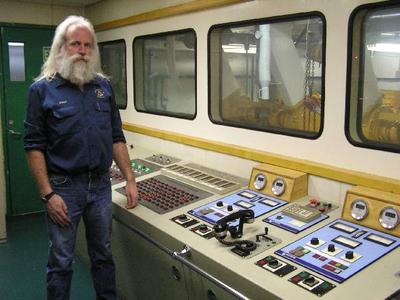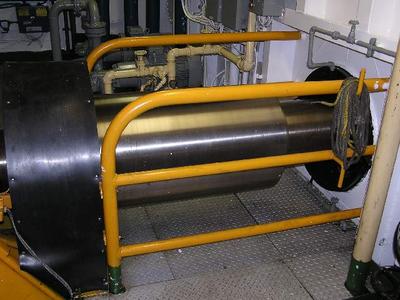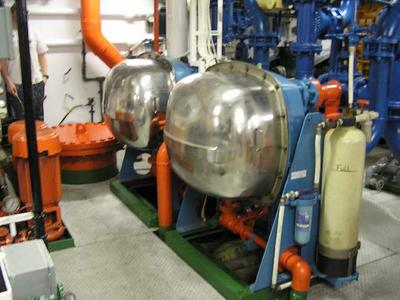12 August, 2003
The forces of nature are all around us. If you think of force as an
influence that exerts itself on something to change its movement or
shape, then a quick look outside will reveal nature's forces at work
everywhere. Up here, in the Arctic, the most obvious example is the
wind upon the sea and ice as it shapes the waves and pushes the ice
pack.
There are unseen forces at work as well. Every time that the CTD
rosette is lowered into the seawater we measure the water pressure at
various depths below the surface. (Look at 15 July for evidence of
this kind of force.) There are ocean currents too. Certainly the
Gray Whale that I observed today breeching the surface is a force of
nature of one kind or another. And there is something else about
these forces that we are often reminded of: they are largely beyond
our control.
There are forces, however, that we do manage to manage. This is
usually accomplished by machines. A machine is a device that
transmits or modifies a force to do work. Work, to a physicist, is
simply force multiplied by distance. Put another way, to do work,
something must be moved. And it's the same for our ship.
Curious about just what drives the Palmer, I arranged for a tour of
the Engine Room with Chief Engineer Dave Munroe. First stop was the
Control Room. It reminded me of the control rooms in hydroelectric
dams that I have seen with panels containing rows and rows of lights
and buttons. From there we passed by three shiny stainless steel
containers that produce all of the ship's water. These water makers
distill the salt out of the seawater, so literally, we have been
"taste testing" much of what we have been sampling during the cruise.
Next were the four diesel engines (about 3300 horsepower each) and
generators that produce the ship's power. It's the force produced by
these huge eight cylinder engines that is transmitted to the two, 13
inch diameter propeller shafts that make the Palmer move. Under most
conditions the Palmer runs on two engines, but on the few occasions
that we have encountered heavy ice, all four were put into action.
The icebreaker also has separate side thrusters in the bow (1,500 hp)
and the stern (800 hp) for maneuvering, although Dave claimed that
the ship could do 2 or 3 knots using the bow thruster alone.
Typically the Palmer will go through 7,500 gallons of diesel a day.
Of course, breaking ice requires more work, so fuel consumption may
go up to 15, 000 gallons/day. The Palmer began the cruise with a
little more than 400,000 gallons of fuel. Today, about 236,000
gallons remain.
We completed the tour in the repair shop and spare parts room. This
made real for me just how independent the ship actually is during
each cruise. Early on in our voyage, for example, the ship's general
alarm bells sounded one evening when a bearing in one of the
generators seized-up. No big deal for a matter of a few hours, the
ship's engineers replaced the bad bearing with a new one. Needless
to say, they have spare parts for everything, and if they don't,
these highly-skilled engineers and oilers (their helpers) can fashion
just about anything as the situation demands.
Which brings up an important point: In the final analysis, it's the
people that make all of this complex machinery work. Since the
engineers and oilers, work in a restricted part of the ship that we
are not allowed access to, they are probably the least visible group
of people on board. To correct this, herewith are the names of this
ingenious and industrious bunch whose natures' control the forces of
the Palmer:
Chief Engineers Dave Munroe and Johnny (JP) Pierce; 1st Engineer
Robert Morris; 2nd Engineers Edward Forbes and Gerald (JET) Tompsett;
3rd Engineer Fredy Dela Cruz; Oilers Victor Maskey, Rolly Rogando,
Doyle Lee, David Cooley; and, Cadet Tim Kennedy.

Chief Engineer Dave Munroe in the Control Room.

One reason why you need to know what you are doing in the Control Room.

Generators.

A small portion of one of the Palmer's propeller shafts.

The ship's water makers.

Second Engineer Edward (Eduardo) Forbes inspecting one of the engines.
Contact the TEA in the field at
.
If you cannot connect through your browser, copy the
TEA's e-mail address in the "To:" line of
your favorite e-mail package.
|
